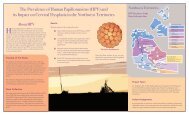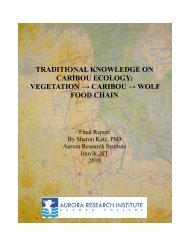Inuit Health Survey: Inuit Health in Transition and Resiliency ...
Inuit Health Survey: Inuit Health in Transition and Resiliency ...
Inuit Health Survey: Inuit Health in Transition and Resiliency ...
Create successful ePaper yourself
Turn your PDF publications into a flip-book with our unique Google optimized e-Paper software.
<strong>Inuit</strong> <strong>Health</strong> <strong>Survey</strong>:<br />
<strong>Inuit</strong> <strong>Health</strong> <strong>in</strong> <strong>Transition</strong><br />
<strong>and</strong> <strong>Resiliency</strong><br />
Inuvialuit Settlement<br />
Region 2008<br />
Helga Saudny, Crystal Lennie, Kue Young,<br />
Grace Egel<strong>and</strong><br />
McGill University / CINE<br />
University of Toronto
Why<br />
<strong>Inuit</strong> want to have <strong>Inuit</strong> specific health <strong>in</strong>formation<br />
With results <strong>in</strong>formed decisions can be made<br />
Overview of health status <strong>and</strong> liv<strong>in</strong>g conditions of<br />
Inuvialuit
Where<br />
Aklavik, Inuvik, Tuktoyaktuk, Sachs Harbour,<br />
Paulatuk <strong>and</strong> Ulukhaktok<br />
When<br />
August <strong>and</strong> September 2008
How<br />
Inuvialuit Settlement Region<br />
Steer<strong>in</strong>g Committee – Qanuqitpit<br />
BDHSSA: Jane Smith<br />
Aklavik: Glen Gordon<br />
Inuvik: Ethel Gruben, Gayle Gruben<br />
Paulatuk: Fred Bennett<br />
Sachs Harbour: Donna Keogak<br />
Tuktoyaktuk: John Stuart JR.<br />
Ulukhaktok: Joshua Oliktoak<br />
Inuvialuit Regional Corporation: Crystal Lennie<br />
GNWT – <strong>Health</strong>: Dr. Kami Kondola<br />
ICHR: Susan Chatwood<br />
Advisor to the Committee:<br />
ARI: Alana Mero<br />
Pr<strong>in</strong>ciple Investigator: Dr. Grace Egel<strong>and</strong><br />
Co-Pr<strong>in</strong>cipal Investigator: Dr. Kue Young<br />
CINE: Helga Saudny
Participatory Processes:<br />
Memor<strong>and</strong>um of agreements<br />
Community – University Research Agreement<br />
Research licenses <strong>and</strong> ethics approval<br />
Development/ref<strong>in</strong>ement of questionnaires<br />
Logistical support
<strong>Survey</strong> content<br />
• Cl<strong>in</strong>ical exam<strong>in</strong>ation<br />
– Body composition (ht,wt,wc)<br />
– Blood pressure <strong>and</strong> pulse<br />
– Skeletal health for women > 40 years<br />
– Diabetes <strong>and</strong> cardiovascular risk factors<br />
• Nutrition markers<br />
• Infection<br />
• Contam<strong>in</strong>ants<br />
• Medical chart review
<strong>Survey</strong> content<br />
• Questionnaires<br />
– Dietary assessments<br />
• 24-hour recall <strong>and</strong> FFQ for country <strong>and</strong> market<br />
food<br />
– Dimensions of health<br />
• Self-reported health/Reproductive health<br />
• Medical history<br />
• Mental well-be<strong>in</strong>g<br />
• Social support<br />
• Physical activity
Preparations <strong>in</strong> coastal communities<br />
Ingrid Tensen, Diane McGlade, Joan Fraser, Herb Nakimayak, Nelli Elanik <strong>and</strong> Joe Kellypalik<br />
•288 Households<br />
• 66% participated<br />
• 34 % unavailable or refused<br />
362 Individuals ≥ 18 years<br />
118 Men<br />
244 Women
<strong>Inuit</strong> <strong>Health</strong> <strong>Survey</strong> Team <strong>in</strong> Inuvik<br />
L-R: Beverly Lennie, Laura Kaufer , Ingrid Tensen, Amy Harty, Mariah Arey-Storr, Rose Day, Nellie Elanik, Jen Jamieson, Dana<br />
Francey, Mearle, Evelyn Wilson, <strong>and</strong> Troy Amos
Transportation to the Canadian Coast Guard Ship Amundsen
Cl<strong>in</strong>ic visit <strong>and</strong> <strong>in</strong>terviews onboard the Amundsen
Communication activities<br />
1. Results booklet on board the ship √<br />
2. Results letters to all participants with<strong>in</strong> 5 months √<br />
3. Results to community health centers √<br />
4. Prelim<strong>in</strong>ary results workshop for steer<strong>in</strong>g committees √<br />
5. Results booklet for communities √<br />
6. IPY – Legacy Photo Project √<br />
7. IHS documentation for Northern Coord<strong>in</strong>ation offices √<br />
8. IPY – Yellowknife Circumpolar Science Conference √<br />
9. IPY – Oslo Science Conference √<br />
10. NWT – IPY Results conference √<br />
11. Peer-reviewed articles<br />
12. Contam<strong>in</strong>ants <strong>and</strong> wellness report
Results for ISR<br />
• Home environment<br />
– Many homes are <strong>in</strong> need of major repairs (new<br />
roof, plumb<strong>in</strong>g repairs)<br />
– Crowded homes are a problem <strong>in</strong> ISR, especially <strong>in</strong><br />
homes with children<br />
– Crowd<strong>in</strong>g = > 1 person/room<br />
– 13% of homes were crowded <strong>in</strong> ISR versus 3% of<br />
non-Aborig<strong>in</strong>al lived <strong>in</strong> crowded homes
Results for ISR<br />
• Smok<strong>in</strong>g<br />
– 82% of homes had smokers (2 per home)<br />
• Smok<strong>in</strong>g was forbidden <strong>in</strong> 70% of homes<br />
• Individual smok<strong>in</strong>g rates are also high<br />
– 65% of participants were smok<strong>in</strong>g at the time of<br />
the survey<br />
– 22% of other Canadians smoked <strong>in</strong> 2007
Cost of liv<strong>in</strong>g <strong>in</strong> ISR<br />
ISR households<br />
Other Canadian<br />
households<br />
$ spent on<br />
food/month<br />
$ spent on<br />
shelter/month*<br />
$ 1,317.00 $ 609.00<br />
$ 1,471.00 $ 1,137.00<br />
* Includes rent or mortgage, electricity, heat<strong>in</strong>g, water, sewage,<br />
garbage
• Food security<br />
Food security <strong>in</strong> ISR<br />
– Food security exists when “all people, at all times, have access to sufficient, safe <strong>and</strong> nutritious food<br />
to meet their dietary needs <strong>and</strong> food preference for an active <strong>and</strong> healthy life”.<br />
• Food <strong>in</strong>security<br />
– Questions related to food security (food shortage, meal skipp<strong>in</strong>g)<br />
• Worried food would run out before you got money to<br />
buy more<br />
• Cut the size of meals, skipped meals, were hungry but<br />
did not eat<br />
• Did not eat for a whole day because there wasn’t<br />
enough money for food<br />
• Could not afford to eat healthy food
Food <strong>in</strong>security <strong>in</strong> ISR<br />
• Moderate food <strong>in</strong>security<br />
– Quality <strong>and</strong>/or quantity of food consumed is<br />
affected<br />
• 2 to 5 positive answers<br />
• Severe food <strong>in</strong>security<br />
– Less food eaten <strong>and</strong> eat<strong>in</strong>g patterns are disrupted<br />
• ≥ 6 positive answers
Food <strong>in</strong>security <strong>in</strong> ISR<br />
Household food <strong>in</strong>security (%)<br />
13 %<br />
Food secure<br />
33 %<br />
54 %<br />
Moderate food<br />
<strong>in</strong>security<br />
Severe food <strong>in</strong>security
Country food <strong>in</strong> ISR<br />
• Country food<br />
– Inuvialuit prefer to eat country food<br />
• Not hav<strong>in</strong>g an active hunter<br />
• Not hav<strong>in</strong>g a boat or skidoo<br />
• Supplies <strong>and</strong> gas are too expensive<br />
• No time<br />
• ~ one-half worry about contam<strong>in</strong>ants <strong>in</strong> country food<br />
• Shar<strong>in</strong>g country food is important to Inuvialuit
Most commonly eaten country food <strong>in</strong> ISR
Most commonly eaten market food <strong>in</strong> ISR<br />
• Regular soft dr<strong>in</strong>ks<br />
– 2 to 4 cans/day<br />
– sugar<br />
– High <strong>in</strong>takes of sugar = <strong>in</strong>creased risk of obesity,<br />
heart disease <strong>and</strong> diabetes
• Average Caloric <strong>in</strong>take is higher among<br />
Inuvialuit compared with other Canadians<br />
• 1/4 to 1/3 of Calories came from food high <strong>in</strong><br />
sugar<br />
• Inuvialuit eat enough prote<strong>in</strong>, fat <strong>and</strong><br />
carbohydrates<br />
• Younger women need to eat more iron-rich<br />
food<br />
• Majority of Inuvialuit need more vitam<strong>in</strong> D
<strong>Health</strong> <strong>and</strong> cl<strong>in</strong>ical data<br />
• Self-reported general health<br />
– 73 % good to excellent<br />
– More men than women said their health was<br />
good or excellent<br />
• At risk waist circumference<br />
– 76% of women<br />
– 56% of men
• Blood lipids<br />
<strong>Health</strong> <strong>and</strong> cl<strong>in</strong>ical data<br />
– Type <strong>and</strong> amount risk for heart disease<br />
• Total cholesterol – 59% high levels<br />
• LDL- cholesterol – 76% good levels<br />
• HDL- cholesterol – 68% good levels<br />
• Triglycerides – 72% good levels<br />
• High triglyceride levels <strong>and</strong> high waist<br />
circumference<br />
– 7.5 times higher risk of diabetes<br />
– Over 1/3 of Inuvialuit have both
Another risk factor for Diabetes<br />
• Blood sugar<br />
• Fast<strong>in</strong>g blood samples were tested for blood<br />
sugar<br />
• Oral glucose tolerance test<br />
• Another blood sample<br />
• 11% of Inuvialuit have blood sugar levels<br />
<strong>in</strong>dicat<strong>in</strong>g pre-diabetes or diabetes<br />
• <strong>Survey</strong> cannot diagnose diabetes or heart<br />
disease
Implications of Research Results<br />
Can lead to policy change*<br />
Can lead to development of new policy*<br />
Can lead to improvement of exist<strong>in</strong>g policy*<br />
* Federal, Prov<strong>in</strong>cial, Regional levels with<strong>in</strong> <strong>Inuit</strong> Regions
Thank you<br />
To all Inuvialuit who participated <strong>in</strong> the survey<br />
community corporations, community health<br />
centers, community research assistants,<br />
nurses <strong>and</strong> staff<br />
ISR steer<strong>in</strong>g committee<br />
Photos by <strong>Inuit</strong> <strong>Health</strong> survey staff<br />
Funded <strong>and</strong> supported by







